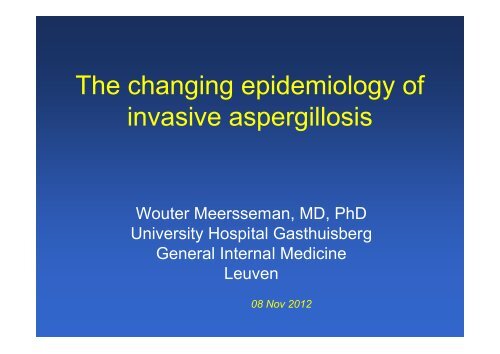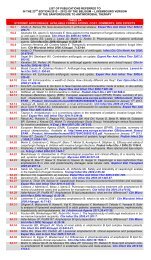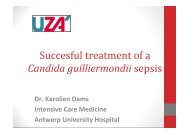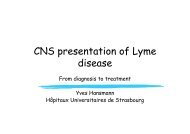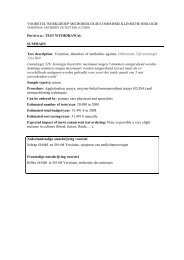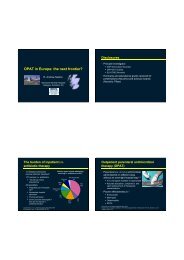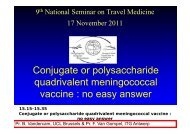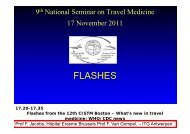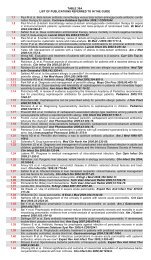The changing epidemiology of invasive aspergillosis
The changing epidemiology of invasive aspergillosis
The changing epidemiology of invasive aspergillosis
Create successful ePaper yourself
Turn your PDF publications into a flip-book with our unique Google optimized e-Paper software.
<strong>The</strong> <strong>changing</strong> <strong>epidemiology</strong> <strong>of</strong><br />
<strong>invasive</strong> <strong>aspergillosis</strong><br />
Wouter Meersseman, MD, PhD<br />
University Hospital Gasthuisberg<br />
General Internal Medicine<br />
Leuven<br />
08 Nov 2012
Outline<br />
• How frequent is <strong>aspergillosis</strong> in the<br />
general population?<br />
• Which diseases are associated with<br />
<strong>aspergillosis</strong>? What are the relative risks<br />
for the different diseases?<br />
• Are there new risk factors on the horizon?
Question 1: What is correct? 00<br />
1 Invasive <strong>aspergillosis</strong> in the ICU is more frequent than<br />
<strong>aspergillosis</strong> in a neutropenic patient on hemato ward<br />
2 <strong>The</strong> incidence <strong>of</strong> mucormycosis = half <strong>of</strong> the incidence <strong>of</strong><br />
<strong>invasive</strong> <strong>aspergillosis</strong>.<br />
3 Based on culture, the highest colonisation rate <strong>of</strong><br />
<strong>aspergillosis</strong> is found in patients with COPD<br />
4 In anti-TNF treated patients, the risk <strong>of</strong> contracting<br />
<strong>invasive</strong> <strong>aspergillosis</strong> is around 20%<br />
5-In patients with chronic granulomatous disease, the<br />
life time risk <strong>of</strong> <strong>aspergillosis</strong> is 30%
Question 2: What is wrong? 00<br />
1 - Aspergillosis in critically ill patients with H1N1 is related to<br />
the steroids that are given to treat the ARDS<br />
2 - Patients with mucormycosis are frequently co-infected with<br />
Aspergillus<br />
3 - <strong>The</strong>re are roughly 500.000 cases <strong>of</strong> acute <strong>invasive</strong><br />
<strong>aspergillosis</strong> worldwide annually<br />
4 Among solid organ transplant recipients, liver<br />
transplants contain the highest risk to develop<br />
<strong>aspergillosis</strong>
Incidence <strong>of</strong> fatal <strong>invasive</strong><br />
mycoses in USA<br />
0.6<br />
Rate per 100,000 Population<br />
0.4<br />
0.2<br />
Candidiasis<br />
Aspergillosis<br />
0.0<br />
1981 1986 1991 1996<br />
Year<br />
Mc Neil et al 2001 Clin Infect Dis 33;641
Estimated number <strong>of</strong> cases <strong>of</strong> <strong>invasive</strong> fungal<br />
infection UK [2002]<br />
Patient group<br />
Number <strong>of</strong><br />
patients<br />
Invasive candidosis/<br />
candidaemia risk<br />
estimates**<br />
Expected number<br />
<strong>invasive</strong> candidosis/<br />
candidaemia<br />
Invasive Expected number<br />
<strong>aspergillosis</strong> <strong>invasive</strong><br />
risk estimates @ <strong>aspergillosis</strong><br />
Allo HSCTx<br />
Solid organ Tx<br />
Leukaemia<br />
Solid tumour<br />
(neutropenic)<br />
793<br />
2953<br />
16269<br />
4% 32 10% 79<br />
5% 148 1.9% 56<br />
3% 488 6% 976<br />
3% 869 2% 579<br />
28955<br />
Advanced cancer 131678 1% 1316 1.5%# 1975<br />
ICU<br />
Burns<br />
Renal dialysis<br />
HIV/AIDS<br />
210130<br />
378<br />
24536<br />
661<br />
1% 2101 0.2% 420<br />
5.6% 21 1.9% 7<br />
0.2% 490 0.02% 5<br />
Probably significant underestimates<br />
0.2% 1 4% 26<br />
Totals 5466 4120<br />
** no estimate for surgical patients, but some are in ICU, or have advanced cancer<br />
@ no inclusion <strong>of</strong> most chronic chest, steroid-treated patients, an increasing group<br />
# the literature figure is 6%, but felt to be autopsy selection bias, so reduced by 75%.<br />
http://www.hpa.org.uk/web/HPAwebFile/HPAweb_C/1196942156347
Prospective data on culture<br />
4 Danish hospitals (3 months) (Jan March 2007)<br />
1. 11.368 airway samples<br />
2. 129 – 151 patients<br />
3. Proven (n=3), probable (n=11), ABPA (n=4),<br />
colonised (n=133)<br />
4. 55% cystic fibrosis, 13% COPD, 7%<br />
hematological, 18% ICU<br />
5. ? Incidence 0.9-1.1 per 100.000 inhabitants<br />
Mortensen KL et al. A prospective survey <strong>of</strong> Aspergillus spp, in<br />
respiratory tract samples. Eur J Clin Microb Infect Dis 2011, 30:1355
An example <strong>of</strong> a prospective data<br />
base<br />
• SAIF network 2005-2007<br />
• 393 adults from 12 hospitals<br />
• 0.271 per 1.000 admissions<br />
- 15% proven disease<br />
- 78% haematological conditions<br />
- 92% lung involvement<br />
- lymphoprolif disorders new emerging group<br />
- 12-week mortality 44.8%<br />
Lortholary O et al, Clin Microbiol Infect 2011, 17, 1882-1889
Examples <strong>of</strong> at-risk patients and pace <strong>of</strong><br />
progression<br />
Risk <strong>of</strong> acquisition (and pace <strong>of</strong> progression)<br />
25%<br />
20%<br />
15%<br />
10%<br />
5%<br />
‘Normal immunity’, high inoculum<br />
Acute respiratory infection, i.e. influenza<br />
Chronic leukaemia<br />
HIV infection<br />
Short course glucocorticoids<br />
Temporary neutropenia<br />
AIDS<br />
Long term glucocorticoids etc<br />
Medical ICU, COPD + sepsis<br />
Solid organ transplant + rejection + CMV<br />
Leukemia and pr<strong>of</strong>ound neutropenia<br />
Allogeneic stem cell transplant + GVHD<br />
Relapsed/uncontrolled leukemia<br />
Degree <strong>of</strong> immunocompromise
Clinical <strong>epidemiology</strong> (US data)<br />
Underlying disease (960 patients) (2004-2008)<br />
1. Haematological malignancy 464 48.3 %<br />
2. Solid organ transplant 280 29.2 %<br />
3. Stem cell transplant 268 27.9 %<br />
4. HIV/AIDS 14 1.5 %<br />
5. Immunodeficiency 4 0.4 %<br />
6. Other 22 2.3 %<br />
Steinbach WJ et al. Clinical <strong>epidemiology</strong> <strong>of</strong> 960 patients with<br />
<strong>invasive</strong> <strong>aspergillosis</strong> from the PATH Alliance registry. J Infect 2012,<br />
65, 453-464
Adult HSCT recipients<br />
D. Kontoyiannis et al., CID 2010,<br />
50: 1091-1100<br />
TRANSNET, 983 IFI<br />
23 US transplant centers<br />
2001-2006
Organ transplant recipients<br />
TRANSNET, 1208 IFI<br />
15 US organ transplant centers<br />
2001-2006<br />
P. Pappas et al., CID 2010, 50: 1101-1111
Increased time to onset <strong>of</strong> IA in SOT
Invasive fungal infections in SOT recipients<br />
Kubak Bm. Transpl Infect Dis 2002; 4: 24-31
Anti-TNF→ granuloma suppression<br />
Mac<br />
Mac<br />
Mac<br />
Mac<br />
Mac<br />
Mac<br />
Mac<br />
Mac<br />
mo<br />
Mac<br />
Mac<br />
mo<br />
mo<br />
mo<br />
mo<br />
Mac<br />
mo<br />
Mac<br />
Mac<br />
8<br />
8<br />
4<br />
8<br />
4<br />
4<br />
8<br />
4<br />
4<br />
4<br />
4<br />
4<br />
8<br />
4<br />
8<br />
8<br />
4<br />
8<br />
4<br />
4<br />
4<br />
4<br />
4<br />
4<br />
4<br />
4<br />
4<br />
4<br />
4<br />
4<br />
4<br />
4<br />
4<br />
4<br />
4<br />
4<br />
4<br />
4<br />
Mac<br />
Mac<br />
Mac<br />
Mac<br />
Mac<br />
mo<br />
Mac<br />
Mac<br />
mo<br />
mo<br />
mo<br />
mo<br />
Mac<br />
Mac<br />
8<br />
8<br />
8<br />
4<br />
8<br />
4<br />
4<br />
8<br />
4<br />
8<br />
8<br />
4<br />
8<br />
4<br />
4<br />
4<br />
4<br />
4<br />
4<br />
4<br />
4<br />
4<br />
4<br />
4<br />
4<br />
4<br />
4<br />
4<br />
4<br />
Macroph<br />
LyT<br />
TNF<br />
TNF<br />
IFN-γ<br />
Anti-TNF<br />
CD4 Tc<br />
CD8 Tc<br />
DC<br />
Fibroblast
Histoplasmosis in anti-TNF-treated<br />
patients<br />
Crohn<br />
Histoplasmosis<br />
?
Anti TNF & Histoplasma capsulatum<br />
10 cases; 9 infliximab<br />
1 wk-6 mo after initiation<br />
9 in ICU, 1 death<br />
Lee, Arthritis Rheum 2002<br />
Increased number <strong>of</strong> cases in USA (240 cases reported to FDA)<br />
3 x more frequent than TB in anti-TNF- living in endemic areas<br />
Most frequent IFI; mortality = 20%<br />
Infliximab (x7) > Etanercept<br />
Pneumonia/dissemination (70-80%)<br />
Hage et al. CID 2010<br />
IRIS = 42% cases in Indianapolis<br />
Screening not useful (Ag/Ab)<br />
Anti-TNF may be restarted if ATF ≥ 1 year without relapse
Incidence <strong>of</strong> IA in immunocompromised children<br />
Underlying disease N Incidence IA (%)<br />
Malignancy<br />
solid tumour<br />
leukaemia<br />
ALL and AML<br />
99 177 0.5<br />
0.1<br />
1<br />
0.6 and 3.7<br />
Hematologic disorder (AA) 12 829 1.4<br />
Immunodeficiency<br />
WAS<br />
CGD<br />
CID<br />
cong. hypogammaglobulinaemia<br />
BMT<br />
allogeneic<br />
autologous<br />
Solid-organ transplant<br />
lung<br />
heart<br />
liver<br />
3733<br />
267<br />
322<br />
411<br />
119<br />
3013<br />
2219<br />
822<br />
1593<br />
39<br />
278<br />
569<br />
Zaoutis et al. Pediatrics 2006; 117: e711-e716<br />
3.2<br />
30<br />
6.5<br />
1.7<br />
3.3<br />
3.4<br />
4.5<br />
0.3<br />
0.3<br />
5<br />
0.3<br />
0.5
Where in the hospital does <strong>invasive</strong> <strong>aspergillosis</strong><br />
occur?<br />
Cornillet et al, Clin Infect Dis 2006;43:577
Parameter<br />
All<br />
(n=1<br />
27)<br />
Proven<br />
(n=56)<br />
Probable<br />
(n=49)<br />
Possible<br />
(n=2)<br />
Colonization<br />
(n=20)<br />
Age, yrs, mean 61 59 63 61 64<br />
Sex, male, n 84 39 35 2 8<br />
Haematological patients, n 38 26 12 0 0<br />
Nonhematological patients, n 89 30 37 2 20<br />
COPD, n 35 12 21 2 0<br />
Solid organ<br />
9 4 5 0 0<br />
transplants, n<br />
Systemic disease, n 17 6 8 0 3<br />
Cirrhosis, n 6 3 0 0 3<br />
Other, n 22 5 3 0 14<br />
SAPS II, mean 54 57 52 43 54<br />
Predicted mortality, % 53% 58% 49% 31% 51%<br />
Observed mortality, % 86% 98% 90% 0% 50%<br />
ICU length <strong>of</strong> stay, days 20 14 23 6.9% 32<strong>of</strong> all admissions 28<br />
Hemodialysis in ICU, n 54 27 20 0 Retrospective 7<br />
Mechanical ventilation, n 123 56 47 A lot 2 <strong>of</strong> autopsy 18data<br />
Neutropenia (
1109<br />
admissions<br />
Medical ICU<br />
18 months<br />
(06/05-12/06)<br />
Modified<br />
EORTC<br />
criteria<br />
Solid cancer: n=23<br />
Systemic<br />
disease: n=16<br />
Solid organ transplants:<br />
n=6<br />
COPD: n=15<br />
Other n=6<br />
Solid cancer; 2<br />
n = 110<br />
Hematological<br />
malignancy: n=36<br />
Cirrhosis: n=23<br />
Proven: n = 26 .<br />
Hematological malignancy<br />
Cirrhosis<br />
COPD<br />
Solid organ transplants<br />
Systemic disease<br />
Solid cancer<br />
Other<br />
Am J Resp Crit<br />
Care Med 2008,<br />
177: 27-34.<br />
Systemic disease; 4<br />
Solid organ ; 2<br />
COPD; 2<br />
Hematological<br />
malignancy; 11<br />
Hematological malignancy<br />
10% <strong>of</strong> Cirrhosis all admissions<br />
COPD<br />
at risk<br />
Solid organ<br />
Prospective study<br />
Systemic disease<br />
2.3% proven<br />
Solid cancer<br />
<strong>aspergillosis</strong><br />
Cirrhosis; 3
Ascioglu S et al. Defining opportunistic <strong>invasive</strong> fungal infection in<br />
immunocompromised patients with cancer and HSCT. Clin Infect Dis 2002; 34: 7-14<br />
De Pauw B et al. Revised definitions <strong>of</strong> <strong>invasive</strong> fungal disease (EORTC/MSG<br />
consensus group) Clin Infect Dis 2008; 46: 1813-21
Clinical relevance <strong>of</strong> Aspergillus isolation<br />
from ETA in critically ill patients<br />
Putative IPA<br />
1. LRT sample positive for Aspergillus (entry criterion)<br />
2. Compatible signs and symptoms<br />
3. Abnormal medical imaging <strong>of</strong> chest<br />
4. Either: (a) Host risk factors:<br />
- neutropenia,<br />
- hemato-oncologic malignancy + cytostatics<br />
- steroid treatment >20 mg/day<br />
- immunodeficiency<br />
(b) BAL:- semiquantitative positive culture +/++<br />
and<br />
- positive cytologic exam (branching hyphae)<br />
Vandewoude K, et al. Crit Care 2006; 10: R31.
Spectrum from colonisation to<br />
<strong>invasive</strong> disease<br />
Colonisation<br />
Possible<br />
Putative<br />
Proven
Incidences <strong>of</strong> mucormycosis over 6<br />
decades (1940–1999), by host<br />
population, 929 cases<br />
Roden M et al., CID, 2005;41(5):634-53.
Incidence <strong>of</strong> mucormycosis cases in a<br />
Belgian hospital from 2000 through<br />
2009<br />
• 31 patients: 21 proven, 10 probable<br />
• M/F: 16/15<br />
• Mean age: 54 years (12-79 years)<br />
• 61% haematological patients<br />
• 45% co-infections with Aspergillus (halo-sign!)<br />
• Mortality rate = 65% (48%, directly related to<br />
infection)<br />
V. Saegeman et al., Emerg Infect Dis 2010, 16: 1456-1458.
Distribution <strong>of</strong> mucorales in France<br />
• « Retrozygo», 101 mucormycosis cases 2005-2007<br />
Cunninghamella spp.<br />
7%<br />
Other<br />
8%<br />
Rhizomucor pusillus<br />
7%<br />
Rhizopus oryzae<br />
32%<br />
Rhizopus<br />
microsporus<br />
17%<br />
Lichtheimia spp.<br />
29%<br />
Lanternier F, CID 2012
Azole resistance frequency<br />
in A. fumigatus 1997–2009<br />
Bueid A et al. J. Antimicrob. Chemother. 2010;65:2116-2118
Emergence <strong>of</strong> azole resistance in Aspergillus<br />
fumigatus and spread <strong>of</strong> a single resistance<br />
mechanism<br />
R mechanisms:<br />
TR/L98H in 30 <strong>of</strong> 32<br />
(94%) isolates<br />
Snelders E et al., PLoS Med 2008;5:e219
Some conclusions…<br />
• It is difficult to determine true incidence figures<br />
(roughly between 2-10%)<br />
• New risk groups have arisen (mainly COPD,<br />
critically ill patients, steroid treated patients)<br />
• Some genetic factors might be important,<br />
especially in immunocompromised patients<br />
• Be aware <strong>of</strong> azole resistance<br />
• Be aware <strong>of</strong> co-infections aspergillus - mucor


